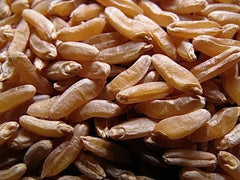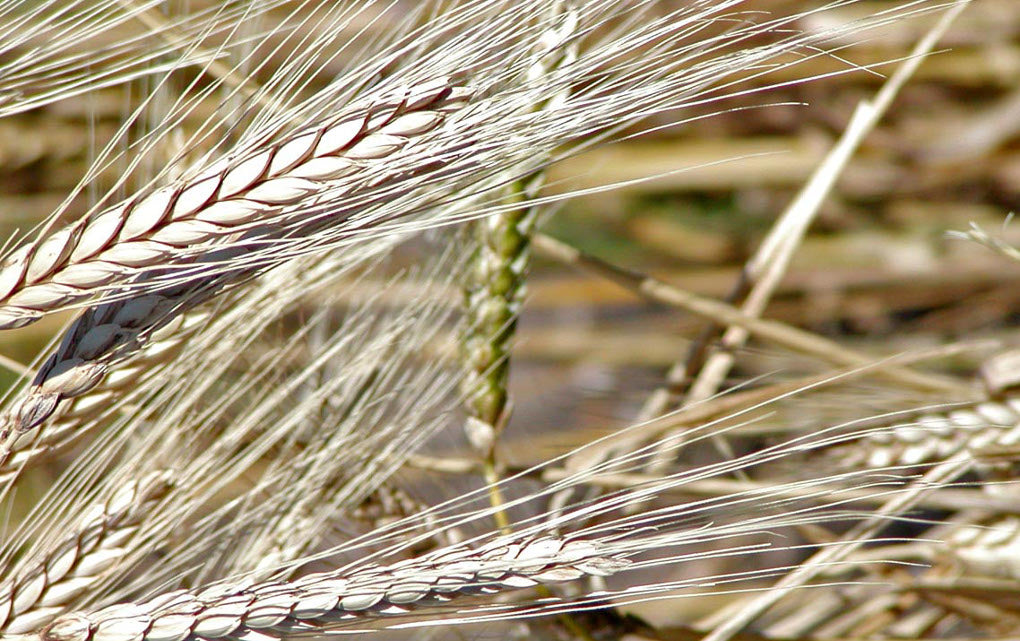As we continue our Ancient Grain series, we examine Khorasan wheat (Triticum turgidum ssp. turanicum; also known as Triticum turanicum). This grain is an ancient relative of modern wheat whose but whose berries are twice the size of modern wheat berries.
Khorasan is known for its rich, nutty flavor and smooth texture in baking.1 Bob’s Red Mill promises, “It is a great choice for whole-grain baking and its buttery, nutty flavor enhances pretzels, bread, cookies, muffins, crepes, waffles, and more.”
In the USA, Khorasan is often marketed commercially under the name Kamut®. But don’t be fooled; Kamut is just the Quinn Family’s trademark for an old variety of Khorasan. The Quinns are Montana Farmers, who grow this strain as an heirloom grain under the trademarked name Kamut. “It is a protected, cultivated variety that remains unhybridized, organic, and meets certain nutritional characteristics.”2
Nutritional Information
 ( Khorasan wheat berries are twice the size of modern wheat pictured here. Chart to the left compiled from USDA sources by Wikipedia)
( Khorasan wheat berries are twice the size of modern wheat pictured here. Chart to the left compiled from USDA sources by Wikipedia)
“Khorasan is large kernel wheat with more protein, lipids, amino acids, vitamins, and minerals than modern wheat.”3 Khorasan is 15% protein,in addition, berries contain 11% water, 70% carbohydrates, and 2% fat.
According to the USDA Food Data Central, in 100 grams (or about three slices of bread) Khorasan provides 337 calories and is a good source of the Daily Value (DV) of protein (29% DV)and dietary fiber (46% DV).
It is also a good source of many essential nutrients, including several B vitamins and dietary minerals, especially manganese (136% DV). The Bakers Journal further reports Khorasan is higher in vitamin E, magnesium, selenium, and zinc than most modern wheat.4
Health Benefits
Khorasan wheat has nearly two and one-half times more resistant starches than most commercial wheat. Brandi Cowan explained that these resistant starches help the body absorb nutrients during digestion. They also “improve insulin sensitivity in diabetics, produce satiety, and promote the growth of beneficial, or good, intestinal bacteria while discouraging the growth of harmful or bad bacteria.”5
When animals ate Kamut bread, they responded better to “oxidative stress than animals fed bread made with modern wheat varieties. The findings suggest that Kamut’s antioxidant properties may reduce the risks of chronic illnesses such as heart disease and diabetes. According to the report in Frontiers of Bioscience,6a making Kamut wheat bread using sourdough fermentation techniques can enhance these beneficial properties.”6b
Cowan did warn that this variety of wheat may not safe for people with gluten sensitivity or other wheat allergies; “However, research has shown that many people with wheat allergies can eat Kamut without experiencing any ill effects. A study by the International Food Allergy Association found that 70 percent of research participants with severe wheat allergies reported being able to eat foods made from Kamut with no or minor reactions.”6c
History
Khorasan gets its name from an ancient region that comprises areas of modern northeastern Iran, part of Afghanistan, and some of Central Asia. In fact, Quinn’s strain of Khorasan wheat originally came from an Egyptian tomb. A WWII airman mailed home just 36 kernels of the wheat. “Regardless of where it originated from, today Kamut is grown across Alberta, Manitoba, and Saskatchewan, and several of the Great Plains states. In 2010, Kamut International reported 130 co-operative, organic family farms grew 35,000 acres of Kamut across North America.”7
Health Benefits Beyond the Immune System
“Is ancient wheat healthier than modern wheat?” is the question the Oldways Whole Grains Council asked in 2013. The answer then was, “In some respects, it may be.” But since then additional studies have confirmed their initial findings regarding Khorasan positive effects on “inflammation, cardiovascular disease, and type 2 diabetes.”8 Sadly these studies did not include a direct study of the immune system.
Still, they reported “following the KAMUT® wheat phase of the study, subjects’ total cholesterol decreased on average 4.0%, their LDL (‘bad’) cholesterol decreased 7.8%, and certain markers of inflammation dropped 23 to 36%.” This while, “following the modern wheat control phase, total cholesterol dropped 2.1% and LDL dropped 2.8%, while potassium and magnesium actually decreased slightly; the three inflammatory markers were mixed with one almost neutral, another dropping 14% and one increasing 15%.”9
Then in 2015, a “CVD trial showed similar decreases in total cholesterol (6.8%) and LDL cholesterol (8.1%) and showed blood levels of potassium and magnesium both rising 2.3%. After the modern wheat control phase, the subjects’ total cholesterol and LDL cholesterol actually rose 3.0% and 1.7% respectively, and both potassium and magnesium levels fell slightly.”10
Time to Try Khorasan
You can order this and other ancient grains from Greg Hall at khorasanmills.com. He carries both Khorasan White Flour, which compares with Kamut® brand flour and Organic Khorasan Wheat Berries that you can grind fresh yourself, along with other select ancient grains.
That means there really is no excuse not to start trying out this grain. And with his recipe index, it looks like it is time for this baker to try his hand at Sourdough Khorasan bread. (More on this later this week.)
If you have worked with this grain, do share your best and worst experiences with our readers in the comment section below.
References
1 Haleem, Seleem, and Galal, “Assessment of Kamut wheat quality”. World Journal of Science, Technology and Sustainable Development, 2012
2 Kamut® (Khorasan) Sourdough Bread, Breadtopia
3 îbid.
4 Brandi Cowen “Kamut or Khorasan?” Bakers Journal, February 3, 2012
5 Department of Food Sciences at the University of Bologna, “Role of cereal type and processing in whole grain in vivo protection from oxidative stress,” Frontiers in Bioscience 16, pp 1609-1618, January 1, 2011
6abc Cowen, îbid.
7 Cowen, îbid.
8 Cynthia, with updates by Caroline, “Health Studies: Kamut Wheat vs Modern Wheat,” Oldways Whole Grains Council, 2013, updated in 2017
9 ibid.
10 ibid.

Author: Darryl Alder lives with his wife in Riverside Lodge, which is their home along the Provo River in Utah. He is a retired career Scouter and outdoorsman who spent many hours over a campfire using a Dutch oven and loves sharing recipes for the kitchen and the campfire alike. You can read many of his recipes on this site by searching for Sourdough Saturday or Recipes in the search feature above.

